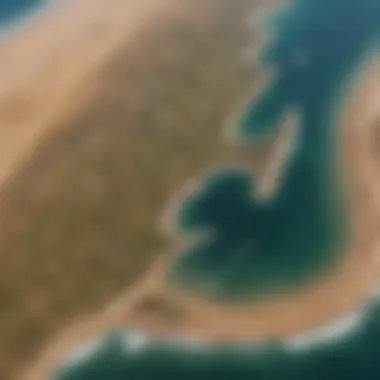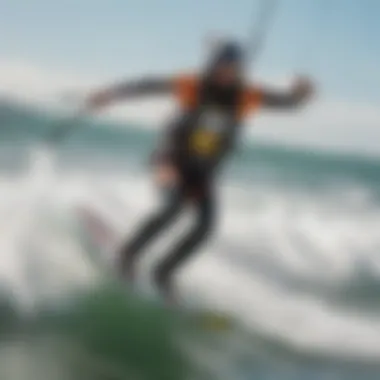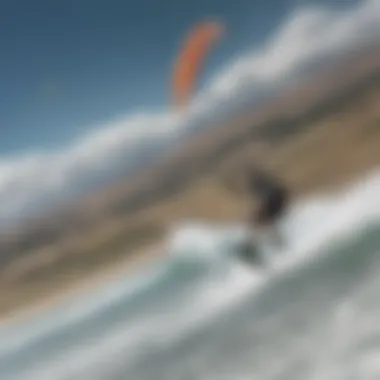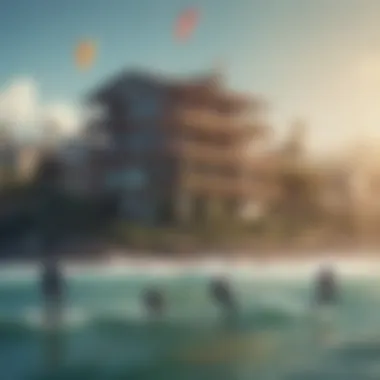SF Wind Map: A Key Tool for Kiteboarding Success


Intro
For kiteboarding enthusiasts, the thrill of gliding across the water and harnessing the wind's energy is an exhilarating adventure. However, the unpredictable nature of wind patterns often complicates the planning process for a perfect session on the water. This is where the SF Wind Map comes into play, acting like a guiding hand for riders who want to maximize their time under the kite. The map is more than just another weather forecast; it offers a detailed breakdown of wind conditions that can make or break a kiteboarding outing.
Understanding the wind is paramount in kiteboarding, as it determines not just your speed but also your safety and enjoyment. Whether you're a seasoned pro or just starting out, the SF Wind Map can serve as an essential tool in your arsenal. This article seeks to unpack the map’s features, functionality, and how it contributes to enhancing your kiteboarding experience. We will investigate the specific tools available to users, cover practical applications for varying skill levels, and consider how community engagement adds depth to this resource.
The essence of enjoying a successful kiteboarding session lies in preparation and knowledge. When you have the right tools—such as the SF Wind Map—at your disposal, you’re much better positioned to make informed decisions. Let’s dive deeper into Equipment Selection, a critical aspect of any kiteboarding adventure, which directly ties into effectively utilizing the wind map's capabilities.
Prologue to the SF Wind Map
Understanding the SF Wind Map is crucial for kiteboarding enthusiasts who want to maximize their time on the water. This resource goes beyond mere visuals; it provides significant data that can influence kiteboarding outings from beginners to seasoned veterans. With the intricacies of local wind conditions at their fingertips, users can make informed decisions that align with their skill levels and safety needs.
Purpose and Relevance
The primary aim of the SF Wind Map is to supply detailed wind information that kiteboarders need for effective planning. Its relevance cannot be overstated—kiteboarding hinges on wind conditions, with different intensities and directions determining when and where to go out. Whether you’re just picking up the sport or you're an expert looking to push your limits, knowing when the wind will be favorable is like having a treasure map. A strong wind can take you racing across the water, while poor conditions can dampen the experience or even become dangerous.
In short, the SF Wind Map allows users to:
- Assess real-time wind patterns
- Identify the best times for kiteboarding
- Choose appropriate locations suited to their skill level
How Wind Conditions Affect Kiteboarding
Wind is the lifeblood of kiteboarding; it shapes each ride. Kiteboarders must be attuned to various wind conditions. Steady winds offer a smooth and predictable ride, while gusty winds can lead to sudden changes in speed and direction, requiring quick reflexes. Understanding these conditions can greatly enhance one's enjoyment and safety.
It's also essential to know the difference between offshore and onshore winds. Offshore winds can take you farther out, but they can also make returning challenging. Onshore winds, conversely, usually provide a gentler ride and easier returns. Therefore, considering the wind direction plays a pivotal role in trip planning.
In summary, grasping how wind conditions can impact the kiteboarding experience goes a long way. Adapting to these variable elements, armed with the insights provided by the SF Wind Map, helps enthusiasts make informed decisions, ensuring that their time spent on the water is both exhilarating and safe.
Understanding Wind Patterns
Understanding wind patterns is crucial for kiteboarding enthusiasts. The wind doesn't just carry the kite; it determines how high you'll fly and how smooth your ride will be. Knowledge of wind types and measurement can directly correlate with one’s performance on the water, thus every kiteboarder should develop a solid understanding of these patterns.
Types of Wind
Wind comes in various forms, each affecting the kiteboarding experience differently. Recognizing these types is essential to harness their powers effectively, and to understand what they bring to the table.
Steady Winds
Steady winds are the bread and butter of kiteboarding. This type of wind blows consistently in one direction at a moderate speed. Enthusiasts often prefer steady winds because they allow for predictable and controlled rides. A key characteristic is its consistency, which is usually between 12 to 20 knots, perfect for maintaining stable lift and reducing the chance of abrupt turbulence.
Advantages of steady winds include easier learning curves for beginners and enhanced performance for seasoned kiteboarders. However, they can become monotonous for those craving excitement or variability in their sessions. While steady winds provide a safe environment, they might not deliver the adrenaline rush some riders seek.
Gusty Winds
On the flip side, gusty winds add an element of surprise. This wind type is characterized by changes in speed and direction, which can lead to thrilling but unpredictable kiteboarding experiences. A gusty wind, with its sudden boosts, might tempt experienced riders to push their limits, providing mixed benefits.
The unique component of gusty winds is the challenge they present. While they can provide an exhilarating ride and high jumps, they can also result in hard landings if not properly navigated. The unpredictability requires kiteboarders to constantly adapt, a skill that many aim to hone. Nonetheless, inexperienced riders are generally advised to tread lightly in these conditions.
Offshore vs. Onshore Winds
Another essential aspect to consider is the difference between offshore and onshore winds. Offshore winds blow from the land towards the sea, while onshore winds do the opposite. For kiteboarders, onshore winds are generally more favorable. They provide a continuous flow of wind, making it easier to maintain lift and ensuring a safer experience by keeping users closer to the shore.


Conversely, offshore winds can present multiple challenges. They may lead some kiteboarders to drift farther out, increasing risks associated with strong currents or sudden changes in conditions. Understanding this distinction helps in planning sessions and recognizing safe practices when gearing up for a ride.
Measuring Wind Speed and Direction
Accurate measurements of wind speed and direction are indispensable for kiteboarding success. No one wants to head out only to find the wind doesn’t cooperate.
Wind Instruments
Wind instruments, such as anemometers, are vital tools for accurately determining wind conditions. These gadgets offer real-time data on both speed and direction, allowing kiteboarders to make informed decisions before hitting the waves. Their key characteristic is their precision; knowing the wind conditions can literally make or break a kiteboarding session.
However, one has to be mindful of equipment quality and technology. Not all instruments are equal; some may fail to deliver accurate data or can be impossible to read in certain conditions. Investing in a reliable wind instrument pays off when it comes to enhancing kiteboarding sessions.
Understanding Wind Speeds
Grasping the concept of wind speeds offers a deeper understanding of when and where to kiteboard. Kiteboarding generally thrives in winds between 10 and 25 knots. A rider’s choice of gear can vary greatly within this range. For instance, lighter winds might necessitate larger kites or specific boards designed for lower speeds.
Low wind speeds bring relaxation but can limit performance, while higher speeds boost adrenaline but require advanced skills. Thus, knowing how these speeds feel in real time can greatly influence choices on the water.
It’s not just what the wind's doing; it’s how you respond to it that counts.
In essence, understanding wind patterns is an integral part of the kiteboarding experience. From steady winds facilitating a comfortable ride to the thrilling unpredictability of gusts, these elements significantly shape one's time on the water. By measuring and interpreting wind behavior, kiteboarders can enhance their skills and safety, allowing for more enjoyable sessions.
Navigating the SF Wind Map
Navigating the SF Wind Map is essential for anyone looking to make the most of their kiteboarding experience. It’s not just about checking the weather; it’s about understanding the environment that’s vital to your time on the water. This tool equips enthusiasts with a wealth of information to plan their sessions effectively, ensuring that they choose the right conditions to maximize enjoyment and safety. With kiteboarding, the wind can be fickle, sometimes changing within moments, so being able to accurately interpret and navigate the wind patterns is key.
User Interface Overview
The user interface of the SF Wind Map is designed to be user-friendly, catering to both novices and seasoned kiteboarders. The layout presents data in a clear manner, allowing users to quickly grasp important wind conditions. The map is interactive, letting one zoom in and out to focus on specific areas or to get a broader overview of wind patterns across San Francisco Bay.
Features such as adjustable settings for time frames and wind conditions help kiteboarders to see how conditions change throughout the day. This flexibility is particularly helpful when timing their kiteboarding sessions, allowing users to select optimal periods for riding.
Interpreting Data Points
Interpreting the data points accurately is crucial for making informed decisions about when and where to kiteboard. The SF Wind Map utilizes visual cues such as color coding and symbols to convey wind speed and direction effectively.
Color Coding
Color coding on the SF Wind Map is a standout feature that enhances user understanding. Each color represents a specific wind speed range—ranging from light breezes to strong gusts. This allows kiteboarders to quickly ascertain whether conditions are suitable for their skill level or equipment. For example, green might indicate light winds suitable for beginners, while red signals strong winds better suited for experienced riders.
This system is beneficial because it breaks down complex information into an easily digestible format. One key characteristic of color coding is its immediacy; you can glance at the map and know what to expect without having to dive into numerical data. However, while this feature is helpful, it’s essential to consider it alongside real-time reports or personal observations, as local weather can sometimes deviate from these color indicators.
Wind Arrows and Symbols
The use of wind arrows and symbols is another integral aspect of the SF Wind Map. These arrows indicate the direction of the wind, providing critical information that complements the speed data shown by color coding. Understanding the prevailing wind direction is vital for kiteboarders since it affects everything from takeoff to how the kite responds once in the air.
A key feature of the wind arrows is their clarity—regardless of your level of expertise, you can quickly identify how the wind will behave. The information conveyed by these symbols helps kiteboarders anticipate their current trajectory and adjust their maneuvers as necessary. However, it’s worth noting that wind can sometimes behave unpredictably, so while the arrows provide a solid guideline, keeping a watchful eye on the conditions remains essential.
Navigating the SF Wind Map goes beyond just reading data; it's about creating an informed approach to kiteboarding that enhances both safety and fun.
Practical Applications of the SF Wind Map
Understanding the practical applications of the SF Wind Map is essential for kiteboarding enthusiasts. This resource offers real-time and historical wind data that directly influences the success and enjoyment of a kiteboarding session. Using this information, participants can better strategize their outings, thus improving their experience out on the water. Whether you're a seasoned pro or a newcomer to the sport, employing the wind map effectively can make all the difference between a good day and a great day.


Planning Kiteboarding Sessions
Planning your kiteboarding sessions is not just about picking a date and hitting the beach; it’s an art that involves studying wind patterns, tide schedules, and potential weather changes. The SF Wind Map breaks this down efficiently. By paying attention to the predicted wind speed and direction, you can determine the best times to harness favorable conditions.
For example, if the map shows that winds will be stronger in the afternoon, you might choose to schedule your session then. Conversely, if you see a drop-off in wind strength, it's wise to reconsider the timing. Keeping an eye on variations helps in avoiding those dreaded afternoons when you’re just sitting on the shore, waiting for the wind that never comes.
Identifying Optimal Locations
The SF Wind Map allows for an exploration of various kiteboarding spots around the Bay Area where conditions vary dramatically due to geographical features. For instance, specific areas like Crissy Field might receive consistent winds while other locations may not have the same pattern.
Some points to consider when identifying locations include:
- Local Topography: Hills or buildings can create wind shadows, causing unpredictable changes in wind conditions.
- Tides: Understanding the tidal rhythms can also enhance your experience; some locations are better at certain tidal stages.
- Crowd Levels: The map can help you find less populated areas for those who prefer a quieter session.
Selecting a spot based on reliable data ensures that your kiteboarding adventure is as enjoyable as possible, whether you’re a solo rider or part of a group.
Safety Considerations
While the thrill of kiteboarding is undeniable, it’s imperative to prioritize safety—especially when wind conditions can shift without notice. Careful analysis of the SF Wind Map can alert you to potential hazards, such as sudden gusts or offshore winds that could make navigating back tricky.
Here are some safety tips when using the wind map:
- Monitor Wind Changes: Always check the latest readings before and during your session. If conditions have changed significantly, don’t hesitate to reevaluate.
- Know Your Skill Level: Don’t push your limits. If the map indicates high winds, consider whether you are ready to handle them.
- Bring a Buddy: Kiteboarding is more fun with friends, and it's safer too. In case of an emergency, having someone nearby can be crucial.
"Safety is not a gadget but a state of mind."
Enhancing Community Knowledge
Building a community around kiteboarding is like casting a net into the vast ocean of information and shared experience. The SF Wind Map serves not only as a tool for individual kiteboarders but also as a means to foster growth and learning within the kiteboarding community. The importance of enhancing community knowledge cannot be overstated; it significantly contributes to the overall kiteboarding culture and safety on the water.
User Contributions and Feedback
One of the cornerstones of the SF Wind Map's value is the wealth of data generated by its users. Kiteboarders who actively contribute their observations, experiences, and insights elevate the quality of information available to all users. They share details about current wind conditions, revealing nuances that may not be captured by automated systems. This real-time feedback mechanism is invaluable, especially in situations where conditions rapidly change. For instance:
- Users might report a sudden gust that isn't reflected yet on the map.
- Someone might note that a certain local spot, often overlooked, has ideal wind conditions that day.
This collective wisdom is what transforms the map from a simple tool into a thriving knowledge exchange platform. By contributing to the map, users can help fellow kiteboarders avoid pitfalls and maximize their enjoyment on the water. Feedback loops not only keep information updated, they create a harmonious dialogue among community members.
Integration with Social Media Platforms
In today's digital age, integrating the SF Wind Map with social media platforms broadens its reach and accessibility. By connecting kiteboarders through channels like Facebook, Reddit, and specialized kiteboarding forums, the map transforms into a social hub for enthusiasts. This connection provides several benefits, such as:
- Real-time Updates: When users post conditions on social media, it becomes easier for others to stay informed about current situations at various locations.
- Event Organization: Kiteboarding events can be planned more efficiently, creating opportunities for community interaction. Groups can rally at specific spots, energized by collective enthusiasm.
- Skill Sharing: Experienced kiteboarders can offer tips and tricks to newbies, with social media serving as the platform to share video tutorials, gear recommendations, and local knowledge.
The synergy between the SF Wind Map and social media not only enhances individual kiteboarding experiences but also strengthens the sense of belonging and support within the kiteboarding community. As users navigate the waters, both literally and figuratively, this collaborative approach fosters a more informed and engaged group of kiteboarders.
"Knowledge is power, but knowledge shared is community."
Limitations of the SF Wind Map
While the SF Wind Map is an instrumental aid for kiteboarding enthusiasts, it’s essential to acknowledge its limitations. Understanding these constraints not only prevents misuse of the tool but can also guide users in adopting more critical approaches to their sessions. Recognizing shortcomings encourages a deeper inquiry into how to interpret and use the data effectively for safe and satisfying kiteboarding experiences.


Data Accuracy and Reliability
One of the significant concerns with any mapping tool involves the accuracy of the data. The SF Wind Map draws on various sources that provide wind speed and direction, including local weather stations and global modeling systems. However, there are nuances that might affect data accuracy:
- Weather Station Variability: Some stations may not be accurately calibrated or adequately maintained, leading to discrepancies in wind readings.
- Timing of Data: Wind conditions can change on a dime. A map that shows a stable reading may not necessarily reflect real-time changes due to sudden gusts or shifts in weather patterns.
- Scale of Measurement: The data provided might aggregate wind measurements, thereby averaging out unique local conditions that could be critical for kiteboarding.
These factors may give users a false sense of security or lead to misinformed decisions about where and when to kiteboard.
Geographic Limitations
The scope of the SF Wind Map is inherently tied to the geographic areas it covers. Here are a few considerations regarding its geographic limitations:
- Limited Coverage Area: The map is primarily focused on San Francisco and may not include nearby places where kiteboarding is popular, like Alameda or Pacifica. For kiteboarders venturing beyond the iconic city, this may result in missed opportunities.
- Local Topography: The intricate geography of the Bay Area affects wind patterns significantly. Wind can funnel through certain valleys, create turbulence in spots, or become entirely blocked by natural obstacles like hills or buildings. This means that while the map may show favorable conditions, actual experience on the water might differ.
- Microclimates: The Bay has unique microclimates that are not easily captured in broader maps. Some kiteboarding locations may experience radically different winds than what the general map would suggest.
Understanding these limitations equips users with more realistic expectations. It shifts focus from relying solely on the map to developing a comprehensive understanding of local wind dynamics, enhancing kiteboarding safety and enjoyment.
"The perfect day for kiteboarding can turn on a dime, especially if one relies too heavily on faulty intel. Experience is the best guide."
Embracing a balanced view that considers both the strengths and limitations of the SF Wind Map empowers kiteboarders to make informed decisions about their time on the water.
Future Developments and Innovations
As kiteboarding continues to rise in popularity, tools like the SF Wind Map are evolving too. Understanding future developments and innovations in wind mapping is not just about keeping up with trends; it's about enhancing safety, performance, and accessibility for all kiteboarding enthusiasts. The evolving landscape of kiteboarding requires adaptable resources that cater to diverse user needs. With advancements on the horizon, kiteboarders can look forward to improved technology that promises to make their experience both safer and more enjoyable.
Technological Advancements in Wind Mapping
The world of technology moves at a breakneck speed, and wind mapping is no exception. Future technological advancements are poised to significantly refine how kiteboarders interpret wind data. With the integration of machine learning algorithms and real-time data analytics, users may expect adjustable forecasts based on the latest information. This means that instead of relying on static models, the SF Wind Map could soon provide dynamic updates reflecting current wind conditions as they change throughout the day.
Additionally, the development of drone technology for wind assessments could play a pivotal role. Drones equipped with sensors can capture wind speed and direction at various altitudes and locations, giving kiteboarders a more nuanced understanding of environmental conditions. This triangulation of data ensures that decisions made before heading out onto the water are backed by concrete evidence rather than vague assumptions.
Moreover, integrating augmented reality features could transform the experience even more. Imagine kitesurfers using AR glasses that can overlay wind data provided by the map in real-time, allowing them to adjust their plans based on live information. Such innovations would not only enhance the thrill of kiteboarding but also promote safety through better-informed decisions.
Community-Driven Projects
The strength of the kiteboarding community lies in its shared passion and knowledge. Engaging users in developing projects related to the SF Wind Map could lead to exciting innovations. Community-driven initiatives can take many forms, one of which includes collaborative data collection. Kiteboarders can share their personal experiences and observations, feeding valuable real-world data back into the platform. This kind of grassroots contribution can vastly improve the accuracy of the map over time.
Furthermore, establishing feedback loops within the community can facilitate ongoing improvements in the map’s functionality. For example, a suggestion box feature on the platform could allow users to request enhancements or report inaccuracies they’ve noticed while out on the water. Involving community voices in the evolution of the SF Wind Map fosters a sense of ownership and connection, ensuring that the tool is tailored specifically to kiteboarders' needs.
Community gatherings or forums, both online and offline, can also serve as valuable backdrops for discussing desired features and improvements. Platforms like Reddit and Facebook serve as excellent venues for this, connecting enthusiasts from all backgrounds to share tips and insights. This collective wisdom can lead to breakthroughs that benefit everyone who utilizes the map, ultimately enhancing the kiteboarding experience for all participants.
End
The conclusion serves as a bridge that encapsulates the valuable insights presented throughout the article, reiterating the significance of the SF Wind Map within the kiteboarding community. This map is more than just a collection of data; it acts like a lifeline for kiteboarders keen on optimizing their experience on the water.
Summary of Key Insights
Throughout our exploration, several key aspects of the SF Wind Map emerge as paramount. Firstly, this resource offers a clear view of changing wind patterns, which is essential for planning kiteboarding sessions effectively. Kiteboarders can glean information about:
- Wind Speed and Direction: Understanding these elements allows enthusiasts to select optimal times and locations for their activities.
- Real-Time Updates: Access to current wind conditions can mean the difference between a thrilling ride and a hazardous outing.
- Community Engagement: As users share their experiences and feedback, the ongoing enhancement of the map fortifies its reliability as a tool.
In essence, the wind map serves as a pivotal resource for kiteboarding enthusiasts by facilitating smarter decision-making that enhances safety and enjoyment on the water.
Final Thoughts on Utilization
To maximize the benefits derived from the SF Wind Map, kiteboarders should actively engage with its features. Here's how:
- Regularly Check Wind Conditions: Make a habit of looking at the map before planning trips. Conditions can shift quickly, and staying informed is your best bet for a successful session.
- Contribute to the Community: If you notice changes in wind patterns or have insights on spots that work, share it. This contributes to the richness of the map and assists others.
- Know Your Gear: Matching your equipment to the wind conditions is crucial. Adjusting kite size or board type based on the map's insights can significantly enhance your experience.
Ultimately, leveraging the SF Wind Map optimizes time on the water, fostering a better connection with the elements and fellow enthusiasts. As the wind dances across the bay, understanding its patterns will allow kiteboarders not just to ride, but to thrive.







